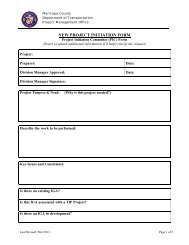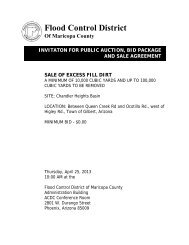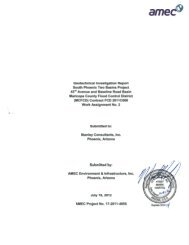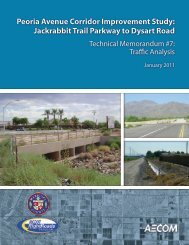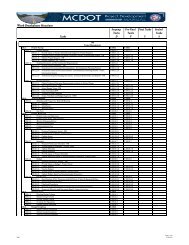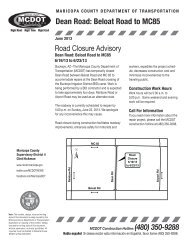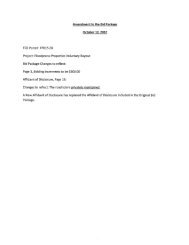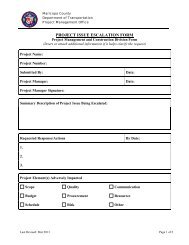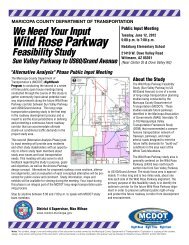Work Plan - Final - Maricopa County Department of Transportation
Work Plan - Final - Maricopa County Department of Transportation
Work Plan - Final - Maricopa County Department of Transportation
You also want an ePaper? Increase the reach of your titles
YUMPU automatically turns print PDFs into web optimized ePapers that Google loves.
Study OverviewThe <strong>Maricopa</strong> Association <strong>of</strong> Governments (MAG) prepared the Interstate 10/HassayampaValley Roadway Framework Study (Hassayampa Framework Study) that identified acomprehensive roadway network to meet traffic demands for the build out <strong>of</strong> the area west <strong>of</strong> theWhite Tank Mountains. This long range regional transportation study identifies the need for aroadway network consisting <strong>of</strong> freeways, parkways, and major arterial roads. The expectation inthe Hassayampa Framework Study is that the parkways will be able to <strong>of</strong>fer significantly greatertravel capacity than that provided by the typical major urban arterial road seen in other parts <strong>of</strong>the region. Hidden Waters Parkway is one <strong>of</strong> the corridors recommended in the HassayampaFramework Study as necessitating a higher capacity parkway cross-section.Hidden Waters Parkway is a north south roadway recommended in the Hassayampa FrameworkStudy. It is designated as a high-capacity facility utilizing the Michigan in-direct left turnintersection design concept and a 200-foot right-<strong>of</strong>-way cross section as set forth in the ArizonaParkway Design Guidelines. The purpose and need for this corridor was confirmed during theMAG study process. Thus, the primary focus <strong>of</strong> this study is right-<strong>of</strong>-way preservation byidentifying opportunities and constraints (fatal flaws) within the two mile wide study area (onemile on each side <strong>of</strong> the base alignment set forth in the Hassayampa Framework Study).The project scope <strong>of</strong> work for the study includes the tasks necessary to prepare a corridorfeasibility report for Hidden Waters Parkway North (Interstate 10 to State Route 74) that willprovide <strong>Maricopa</strong> <strong>County</strong> <strong>Department</strong> <strong>of</strong> <strong>Transportation</strong> (MCDOT), the Town <strong>of</strong> Buckeye(Buckeye), area property owners, developers, and other stakeholders with a planning tool, forfuture growth and development, that preserves the 200-foot right-<strong>of</strong>-way required for theArizona Parkway design. This will require significant coordination with various governingbodies, other public agencies, development interests, and the general public. This study is thefirst step in the development process and is meant to assist the governing bodies in protecting acontinuous corridor that will develop as growth moves to the west.Study AreaThe project study area includes the northern section <strong>of</strong> the Hidden Waters Parkway, as shown onthe Hassayampa Framework Study, from Interstate 10 north to the future alignment <strong>of</strong> StateRoute 74. The study area is approximately 28 miles long and is two miles wide (one mile eachside <strong>of</strong> the alignment as shown on the Hassayampa Framework Study) except in the area fromNorthern Avenue to Bell Road were the study area expands to two miles west <strong>of</strong> the alignmentand from the south end <strong>of</strong> Douglas Ranch to Patton Road were the study area expands to twomiles east <strong>of</strong> the alignment for a total <strong>of</strong> three miles wide in these two areas (refer to exhibit forgraphic depiction <strong>of</strong> study area).Study PurposeThe primary objectives <strong>of</strong> the Corridor Feasibility Study are to: (1) clearly define and assess theproject study area for strategic issues identification; (2) develop and evaluate candidatealignments within the corridor study area; (3) recommend a preferred alignment; and (4)subsequently define the characteristics <strong>of</strong> the preferred alignment in greater detail. This study is





